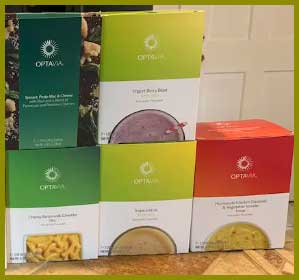Intermittent fasting and meal replacement programs have become increasingly popular for weight loss and health improvement. Two options in this space are ProLon and OPTAVIA. But what exactly are these programs, and how do they compare?
This comprehensive guide examines the key features, pros and cons of ProLon and OPTAVIA to help you determine which may be the better fit.
A Brief Comparison Table
| Feature | ProLon | OPTAVIA |
| Food Options | All whole, natural foods | Primarily processed meal replacements |
| Approach | 5-day fasting mimicking cycles | Continuous daily meal replacement plan |
| Coaching Support | None | One-on-one coaching and community support |
| Cost | $250 per 5-day box | $400+ monthly with membership fees |
| Calorie Intake | 800-1100 calories daily | Varies based on meal plan selected |
| Macronutrients | Higher carb, plant-based | Lower carb, higher protein options |
| Additional Benefits | Cellular recycling and rejuvenation | Habit change, weight maintenance |
| Average Weight Loss | 5-8 lbs per 5 days | Varies based on duration of program |
What Is ProLon?

ProLon is a 5-day meal program designed to mimic fasting through strategic calorie restriction and nutrient optimization.
It was created by Dr. Valter Longo, a leading longevity researcher and professor of gerontology and biological science at the University of Southern California.
ProLon involves consuming specific servings of plant-based soups, snacks, drinks, and supplements each day.
These are meticulously formulated to provide nutrients and antioxidants to support your body while lowering calorie intake to activate cellular recycling and rejuvenation processes similar to a fast.
Here are some key facts about ProLon:
- 5-day program: The core ProLon program lasts 5 days.
- 800-1100 calories per day: Calories are restricted to between 800-1100 per day. This is much lower than a typical diet but designed to avoid complete starvation.
- Plant-based: All ProLon meals and snacks are vegan. The ingredients focus on nuts, olives, soups, herbal teas, supplements and more.
- Once per month: ProLon is designed for a 5-day cycle once per month, with normal eating on regular days.
- Convenience: The cold-packed box provides all preportioned foods needed for the 5 days.
- Research-backed: ProLon is based on 25 years of clinical research on fasting and longevity by Dr. Longo.
What is OPTAVIA?
OPTAVIA is a commercial weight loss program offering packaged meals, one-on-one coaching, and an online community. It was created in 1980 by Dr. Wayne Scott Andersen as Medifast and rebranded to OPTAVIA in 2017.
OPTAVIA involves replacing most of your regular meals with packaged shakes, bars, and snacks. You also consume one self-prepared lean meal and 2 healthy grocery additions daily. Some key things to know:

- Meal replacements: Most meals are replaced with OPTAVIA shakes and bars.
- 4 Optimal Weight 5&1 Plan: The core plan involves 4 packaged OPTAVIA foods plus 1 lean meal daily.
- Coaches: You are assigned an OPTAVIA coach for support and accountability.
- Community: Group support is offered through online classes and OPTAVIA community app.
- Customizable: There are plans for people with conditions like diabetes or teens.
- Processed foods: Shakes contain artificial and processed ingredients to enhance taste.
- Long-term use: OPTAVIA is designed for long-term weight management vs. short cycles like ProLon.
Now that we’ve covered the basics, let’s compare some of the key differences between these two programs.
Key Differences Between ProLon And OPTAVIA
- Whole Foods vs. Meal Replacements
One of the biggest differences between ProLon and OPTAVIA is that ProLon uses only all-natural, minimally processed whole foods. This includes ingredients like olive oil, olives, nuts, seeds, soups, herbal teas, and supplements. ProLon contains no artificial flavors, sweeteners, or processed protein powders.
In contrast, OPTAVIA relies heavily on packaged meal replacement shakes, bars, and snacks. These are formulated for weight loss using artificial sweeteners, protein isolates, fiber additives, and more.
So OPTAVIA provides convenience at the cost of eating mainly processed foods.
- Intermittent Cycling vs. Continuous Use
ProLon is designed for short 5-day cycles interspersed with normal eating, rather than continuous calorie restriction. The 5-day cycles mimic the benefits of periodic fasting while still allowing you to enjoy regular meals on other days.
OPTAVIA is focused on long-term daily use of meal replacements to promote weight loss and maintenance. This can help establish healthy eating habits but may need to be followed indefinitely to maintain results.
- Plant-Based vs. Low Carb
ProLon provides 800-1100 daily calories solely from plant-based whole foods like vegetables, seeds, olives, and nuts. Restricting animal proteins is intended to minimize risk from growth factors and optimize autophagy.
OPTAVIA offers low carb meal replacement options but is not exclusively plant-based. For example, whey protein is commonly used in the shakes. So it’s not optimized for cellular recycling benefits.
- Supervised vs. Solo
ProLon ships as a complete 5-day kit for solo use at home without a coach. Directions and educational tips are provided, but no one supervises your progress.
OPTAVIA connects you with a coach to provide accountability, troubleshooting, and encouragement. You also have access to support groups. So OPTAVIA offers more guidance, but requires membership fees.
- Cost Comparison
ProLon costs $250 for a 5-day box, though discounts may be offered on multiple boxes. Since it is only done monthly, the cost is reasonable.
OPTAVIA costs $400+ monthly assuming 4 meal replacements daily at $5 each. This adds up quickly since it is used long-term for weight management. Membership fees also apply for coaching access.
Also Read: Differences Between Mistobox And Trade Coffee.
Pros and Cons of ProLon and OPTAVIA
Now let’s summarize some of the key advantages and disadvantages of each program:
ProLon Pros
- All-natural, minimally processed whole foods
- Strategically designed for cellular rejuvenation
- Convenience of prepackaged meals/snacks
- Short 5-day cycles with normal eating 6+ days monthly
- Plant-based nutrition profile
ProLon Cons
- Very low calorie approach requires medical guidance
- Only one meal cycle option
- No personalized coaching
OPTAVIA Pros
- Convenient, grab-and-go meal replacements
- Ongoing one-on-one coaching for accountability
- Long-term approach for lasting habit change
- Lower carb and higher protein options
- Large community for support
OPTAVIA Cons
- Heavily processed ingredient profile
- High monthly costs, especially long-term
- Restrictive for continuous daily use
- Cutting out many regular foods
As you can see, each program has unique advantages suited for different needs and preferences.
Which is Better: ProLon or OPTAVIA?
So when considering ProLon vs. OPTAVIA, which program has the edge? Here are some key factors to help determine which may be better for your situation:
- Goals: ProLon is optimized for cellular rejuvenation through fasting-mimicking effects. OPTAVIA is better for steady weight loss and habit change.
- Ingredients: ProLon uses all whole foods. OPTAVIA relies heavily on processed meal replacements.
- Timeline: ProLon is short-term 5-day cycles. OPTAVIA is for long-term daily use.
- Support: OPTAVIA offers more guidance and community. ProLon is solo.
- Cost: ProLon is cheaper for intermittent use. OPTAVIA is pricier for ongoing costs.
Overall, ProLon is best for periodic resetting via fasting-mimicking cycles using whole foods. OPTAVIA is preferable for steady progress if you want ongoing coaching, community, and meal replacement convenience.
The program that will work best depends on your specific goals, needs and preferences.
Also Read: Differences Between ProLon And Dr. Kellyann Diet.
Frequently Asked Questions (FAQ)
Yes, most people lose some weight on ProLon. Average weight loss is 5-8 pounds over the 5 days due to calorie restriction. Some also continue to lose additional weight after resuming normal eating.
Clinical studies show average weight loss around 5-8 lbs during the 5 days on ProLon. This represents mainly water weight and glycogen depletion. Some users have reported losing up to a pound a day.
For the 5-day ProLon plan, most people lose between 5-8 pounds. Lower calorie intake leads to burning of glucose and liver glycogen stores, releasing their water weight and leading to rapid loss over the 5 days.
No, ProLon does not normally create ketosis. Total carb intake per day ranges from 42-62 grams. To induce ketosis, daily carbs generally must be under 50 grams. Lower calories and periodic fasting effects come from other mechanisms with ProLon.
Also Read: Comparison Between Atkins And Optavia
Final Thoughts
So in summary, both ProLon and OPTAVIA offer interesting alternatives to normal dieting for weight loss and health goals. ProLon provides robust science-backed benefits via periodic short-term fasting cycles.
OPTAVIA promotes steady progress through meal replacements and coaching. Comparing the pros and cons of each can help you determine if either program is a good fit. Whichever route you choose, be sure to consult your doctor and focus on healthy, sustainable lifestyle habits.
